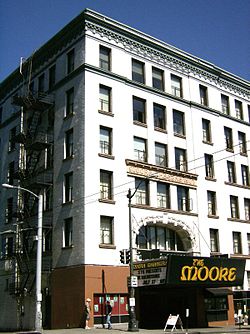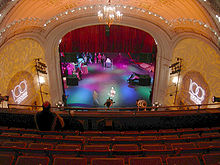- Moore Theatre (Seattle, Washington)
-
Moore Theatre and Hotel
 Entrance to The Moore Theatre at the corner of 2nd Ave. and Virginia St.
Entrance to The Moore Theatre at the corner of 2nd Ave. and Virginia St.Location: 1932 2nd Ave
Seattle, WashingtonCoordinates: 47°36′42.45″N 122°20′28.85″W / 47.6117917°N 122.3413472°WCoordinates: 47°36′42.45″N 122°20′28.85″W / 47.6117917°N 122.3413472°W Architect: E.W. Houghton NRHP Reference#: 74001958 Added to NRHP: August 30, 1974 The Moore Theatre in Seattle, Washington, U.S.A. is a 1,419-seat performing arts venue located at the corner of 2nd Avenue and Virginia Street, two blocks from Pike Place Market in downtown Seattle. It is the oldest still-active theater in Seattle. The Moore hosts a mix of theatrical productions, musical concerts of many varieties, and lectures. It is currently operated by the Seattle Theatre Group, which also runs the 2,803-seat Paramount Theatre and the Neptune Theater.
Contents
History
Built for Seattle real estate developer J. A. Moore in 1907 and designed by E.W. Houghton, the Moore was a lavish social venue for the Gilded Age elite of early 20th century Seattle. The Moore Theatre and the adjoining Moore Hotel, were designed partly to accommodate and entertain tourists visiting the 1909 Alaska-Yukon-Pacific Exposition; the Moore opened in time for the originally planned date of the Exposition in 1907.
The theater was initially operated by John Cort, later founder of a major Broadway theater venue in New York. Excellent programming carried the Moore through the 1930s, but changes in entertainment gradually led to struggling to survive by the 1970s.
The Moore Theatre and Hotel was placed on the National Register of Historic Places in 1974.[1] The Moore became the Moore Egyptian, taking its moniker from a luxury cinema on The Ave in the University District, which had been converted to a drugstore c. 1960. The Moore Egyptian rescued the theater with innovative programming, and became the cradle of the Seattle International Film Festival (SIFF, founded 1976). Dan Ireland and Darryl Macdonald were the leading talents in the success, but the Moore's owners declined to renew their lease. Ireland and Macdonald moved to a Masonic Temple on Capitol Hill, taking the "Egyptian" name with them.[2]
The Moore has hosted touring musicians and theatrical productions since the 1980s, currently seating about 1,400.[2]
Architecture
Built of reinforced concrete, (plus an enormous steel girder spanning the width of the house, carrying the weight of the balcony without the need for support columns,)[3] and faced with a façade of white ceramic tile and terra-cotta, the theater is a mix of elements of the Byzantine and Italianate styles. Like most theaters, the exterior is relatively plain and stylistically neutral compared to the extravagant interior.
The staging area was the largest of any theater in Seattle, with an electrical system that was state-of-the-art for its time, and unusually numerous dressing rooms. Seating 2,436 in its original configuration, the Moore was one of the largest theatres in the U.S. at the time. The Moore was characterized by innovative architecture, luxurious materials, and sumptuous decor. The upper balcony, although well-appointed for its day, was originally racially segregated from the rest of the theater hall. It once had separate entrances, and to this day has a separate staircase connecting it to just inside the front door.
The Moore's architect, E. W. Houghton, also designed the Seeley Theatre in Pomeroy, Washington.[4] Like the Moore, the Seeley, which currently seats 270 people, features a steel girder supporting the balcony without the need for supporting columns.
In popular culture
- Alice in Chains' Live Facelift home video release was filmed at the Moore Theatre in 1990.
- Pearl Jam's "Even Flow" video consists of video footage taken during a concert at the Moore Theatre in 1992.
- Mad Season's Live at the Moore home video release was filmed at the Moore Theatre in 1995.
- Jeff Tweedy of Wilco uses portions of the footage of his performance at the Moore Theater in the concert film Sunken Treasure: Live in the Pacific Northwest.
- Wanda Sykes filmed her comedy special Sick & Tired here.
- Two Progman Cometh music festivals were held here in 2002 and 2003, resulting in 3 live albums
- Seattle progressive metal band Queensrÿche filmed home-DVDs Mindcrime at the Moore and Live Evolution at this venue.
- James Blunt held a concert here on his All the Lost Souls world tour in 2008.'
- Patton Oswalt's Finest Hour album was recorded at the Moore.
External links
Notes
References
- Flom, Eric L. (2002-06-20), Moore Theatre (Seattle), HistoryLink.org, http://www.historylink.org/essays/output.cfm?file_id=3852, retrieved 2006-07-21.
- NRHP (2006), WASHINGTON - King County, National Register of Historic Places, http://www.nationalregisterofhistoricplaces.com/WA/King/state.html, retrieved 2006-07-21. Link is to first of 5 pages. "Moore Theatre and Hotel" (added 1974) is on p. 3 of 5.
Categories:- Landmarks in Seattle, Washington
- Concert halls in the United States
- Music venues in Washington (state)
- National Register of Historic Places in Seattle, Washington
- Theatres on the National Register of Historic Places in Washington (state)
Wikimedia Foundation. 2010.

